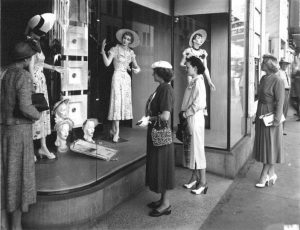
“You mean a woman can open it?” Alcoa Aluminum twist off ketchup bottle advertisement published in 1953.
This historical source was an advertisement for the Alcoa Aluminum twist off ketchup bottle in 1953. This advertisement was just one of many advertisements throughout the 1950s that showed the traits that women were associated with at the time as a motive for women to also contribute to consumerism. Specifically, this advertisement was using the idea that women were less intelligent and weaker than men in order to advertise that since the ketchup bottle could be opened by women, it must be easy and simple to use.
Throughout the 1950s, a consumerism revolution was expanding, and women were gaining slightly more independence from men yet still being limited to being a housewife and mother in the eyes of society. During World War II, women took on many new roles other than tending to family and household duties. Some of these roles included working in factories and textile mills. [1] The role of women was shifting from being a housewife and mother to taking on more responsibilities. This changed led to a bigger emphasis that women were becoming a threat to masculinity, society, and family because they were stereotyped to over-consume and spend more money. [2] Consumption was viewed as women’s work at the time since they had the power to buy and advertisements targeted this by showing the product from a feminine viewpoint. [3]  Despite the changing roles that women were taking on, the views on women remained conservative during this time throughout most of society. With people disregarding the evolving roles that women had, they still viewed women as housewives and mothers and thought of these as their primary duties as a woman. This view was another contribution as to why advertisements degraded women. Since it was common in society to view women as less than men, this became normal for many women who just accepted this treatment. Advertisers knew that advertisements like this ketchup bottle ad would also appeal to men and many women would accept it. The overall goal of these advertisements in the 1950s was to appeal to their audiences and in many cases, it was by portraying women in a degrading view. [4]
Despite the changing roles that women were taking on, the views on women remained conservative during this time throughout most of society. With people disregarding the evolving roles that women had, they still viewed women as housewives and mothers and thought of these as their primary duties as a woman. This view was another contribution as to why advertisements degraded women. Since it was common in society to view women as less than men, this became normal for many women who just accepted this treatment. Advertisers knew that advertisements like this ketchup bottle ad would also appeal to men and many women would accept it. The overall goal of these advertisements in the 1950s was to appeal to their audiences and in many cases, it was by portraying women in a degrading view. [4]
This ketchup bottle advertisement is an example of the role of women in the 1950s as well as how women were portrayed and targeted in advertisements. This advertisement clearly targets women and displays the typical social stereotype that women were faced with in the fifties. In this case, the stereotype was that women were less intelligent and weaker, thus, making them more dependent on men. For example, the phrase on the ad that says “You mean a woman can open it” shows that women were displayed in society as not being capable of doing many other things that men may have been able to do. The advertisement displays a woman shocked and seemingly excited that she is about to open the ketchup bottle. The shocked look on the women’s face exemplifies that it was not necessarily seen as the “norm” for women to be able to do such simple tasks such as opening a bottle of ketchup.  Adding to this, the advertisement targeted women specifically since women were usually the ones shopping for food and cooking for the family. The advertisers tailored to this common duty of wives by emphasizing that women would not need a man to open it for them with the new innovation of the twist off cap. Women would also be likely to buy this product since the societal norm that women are weaker than men were also embraced by women and not solely just men. Overall, this advertisement shows that women would be a primary consumer in buying this product from the company due to their daily duties with cooking and the desire to have an easy and innovative product without the help of a man.
Adding to this, the advertisement targeted women specifically since women were usually the ones shopping for food and cooking for the family. The advertisers tailored to this common duty of wives by emphasizing that women would not need a man to open it for them with the new innovation of the twist off cap. Women would also be likely to buy this product since the societal norm that women are weaker than men were also embraced by women and not solely just men. Overall, this advertisement shows that women would be a primary consumer in buying this product from the company due to their daily duties with cooking and the desire to have an easy and innovative product without the help of a man.
[1] D. E Shi. America: A Narrative History (Brief Eleventh Edition) (Volume 2) (11th ed.). New York, NY: W. W. Norton. (2018), 1047
[2] Emily Rosenburg. “Consuming Women: Images of Americanization in the ‘American Century.’” Diplomatic History, 23 (1999): 494
[3] Diane Barthel-Bouchier,. Putting on Appearances: Gender and Advertising. Women in the Political Economy. Temple University Press, (1988), 6.
[4] Christina Catalano. “Shaping the American Woman: Feminism and Advertising in the 1950s,” Constructing the Past: Vol. 3 : Iss. 1 , Article 6. (2002): 50.
References:
Barthel-Bouchier, Diane L. Putting on Appearances: Gender and Advertising. Women in the Political Economy. Temple University Press, 1988. http://search.ebscohost.com/login.aspx?direct=true&AuthType=sso&db=cat00991a&AN=sth.ocn649741902&site=eds-live.
Catalano, Christina. “Shaping the American Woman: Feminism and Advertising in the 1950s,” Constructing the Past: Vol. 3: iss. 1, Article 6 (2002). http://digitalcommons.iwu.edu/constructing/vol3/iss1/6
Rosenberg, Emily. “Consuming Women: Images of Americanization in the ‘American Century.’” Diplomatic History 23, no. 3 (1999). http://search.ebscohost.com/login.aspx?direct=true&AuthType=sso&db=edsjsr&AN=edsjsr.24913676&site=eds-live.
Shi, D. E. America: A Narrative History (Brief Eleventh Edition) (Volume 2) (11th ed.). New York, NY: W. W. Norton. (2018).
